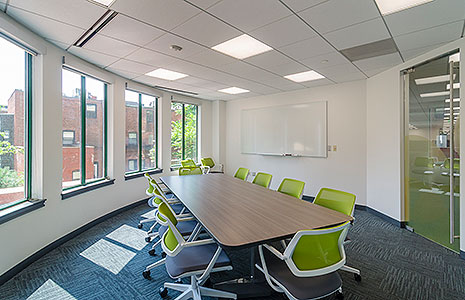
What Happens When Your Office Lighting Connects to the Internet?
We have come a long way since Tim Berners Lee democratized Internet access with the creation of the World Wide Web in 1991. From dial-up and grimy beige desktops to devices that actually listen and act when you speak, the future is even more connected. And while there’s an abundance of chatter regarding the explosive growth in Internet of Things-, or IoT-, tethered devices, the practical challenges of configuring, finding, integrating and managing these devices to deliver value remain.
My colleague Mike Watson made a great point on overcoming these barriers, stating, “Do [smart technology] in a way that blends into the background of a person’s life while making their life seamlessly BETTER. Functionality, simplicity and intelligence in a personalized, user-friendly package.”
So, how does connected lighting play a role? A common misconception is that the IoT enables smart lighting but, unlike many other “things” of the IoT, it’s the converse. Smart lighting enables IoT. LED technology has fundamentally changed the way we light. At the same time, by deploying LED lighting we’re pervasively installing high-power, intelligent digital appliances in all of the spaces where we live and work. Lighting provides a platform to economically deploy sensors, intelligence and connectivity everywhere.
How does this happen? This is where Power over Ethernet (PoE) comes into play and it’s going to happen faster than you might think. PoE is not entirely new but the use with lighting devices is now possible due to advanced LED technology and partnerships between technology leaders like Cree and Cisco.
PoE uses standard Ethernet cables to carry power and data, replacing more expensive AC wiring infrastructure while networking LED lights and a complement of sensors. Instead of wiring the light fixture into a building’s AC electrical system, it’s simply plugged into an Ethernet port and the network.
Cree’s newly announced SmartCast Technology with PoE, for example, works within Cisco’s Digital Ceiling ecosystem to bring a scalable, simple and intuitive solution to create fundamentally better, more intelligent building environments.
How will this affect you?
DESIGN FLEXIBILITY: PoE eliminates the need for separate data connections and power connections for every endpoint, allowing simple, seamless installation in commercial applications. This allows intuitive integration into the environment it is servicing, reducing complexities for facility managers. SmartCast Technology with PoE provides the ability to easily install and commission LED lighting using integrated software and sensors to create groups of lights and associations with switches and dimmers. This “plug and play” capability allows lights to be moved and rearranged as needed without complex rewiring and configuration.
CONTROL AND INTEGRATION: For controlling cost and shaping the environment and user experiences, intelligent lighting PoE solutions will become the standard. A 2015 DOE study offered an aspirational vision: By 2020, a majority of luminaires might be “shipped from the factory with embedded sensors and intelligence” with “installation costs and complexity greatly reduced”. It allows you to measure, monitor and control all aspects of a buildings space, offering high availability for power and uninterrupted service. PoE networked devices will be able to monitor and adjust for occupancy patterns, resource utilization and personal preference, creating a comfortable environment.
USER EXPERIENCE: Lighting systems should be intuitive and automated. If the user has to tell the lights how to behave, then the lights are obedient, not intelligent. Advanced LED technology and PoE systems have the intelligence to make buildings and people more productive while delivering better light for less energy than ordinary lighting systems. An entire building can adapt its environment to suit the occupants, increasing comfort and enhancing productivity all with better light. For example, businesses can set customizable light and room temperatures in reserved workspaces and carry over pre-set phone/IP preferences (extension mobility). Schools can create customized lighting in classrooms to address learning requirements or preferences.
PoE technology enables intelligent lighting systems to lower costs while improving the occupant’s experience, easily integrating lighting systems and the data they provide into the information network. Now companies in the LED and IT industries recognize that LED lighting is the perfect platform to turn the Internet of Things into a workday reality.
reposted from www.RetrofitMagazine.com
